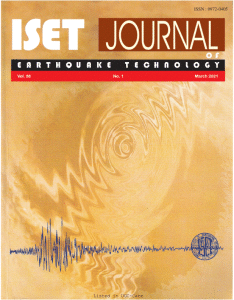Home > Issues & Journals
FREQUENT MODERATE EARTHQUAKES IN THE VICINITY OF THE KULSI FAULT: IMPLICATIONS FOR FUTURE LARGE EVENTS
William Kumar Mohanty, Mohd Shahabuddin, Suvankar Samantaray & Priyank Pathak
Paper No.: 592
|
Vol.: 62
|
No.: 1
|
March, 2025
|
pp. 35-46

Abstract
The Shillong Plateau and Northeast India constitute a seismically active region, influenced by the
Himalayan orogeny and the ongoing collision between the Indian and Eurasian plates. This study
focuses on the seismicity of the Shillong Plateau, with particular emphasis on recent earthquakes
occurring along previously inactive faults, such as the Kulsi Fault. The objective is to understand the
implications for future large seismic events. An earthquake catalog compiled for the period 815–2022,
containing 2,966 events, has been analyzed. Notably, a recent earthquake of magnitude mb 4.3 occurred
in the West Khasi Hills district of Meghalaya, India, on July 16, 2023. Within a 100 km radius of the
Kulsi Fault, 40, 108, and 56 earthquakes of magnitude ranges 4.0–5.0, 3.0–3.9, and 2.0–2.9,
respectively, have been recorded over the past decade. Additionally, the region has experienced six
major earthquakes of magnitude greater than 6.0. The magnitude of completeness (Mc) for the catalog
is estimated at 3.0, with spatial variations ranging from 2.7 to 3.8. The calculated b-value and a-value
for the entire study area are 0.62 ± 0.04 and 4.8, respectively. Spatial mapping of the b-value indicates
that the northeastern segment of the Kulsi Fault is more highly stressed compared to its northwestern
counterpart. Return periods for an earthquake of magnitude 5.8 have been estimated for each of the four
seismic zones delineated. Furthermore, a strike-slip nature for the Kulsi Fault has been identified based
on terrestrial gravity data, with Bouguer anomaly variations ranging from 32.05 to 8.40 mGal across
the fault. Deflected Bouguer anomaly contours along the fault line further corroborate its existence. The
increased frequency of earthquakes in recent years, particularly in the central portion of the Shillong
Plateau, suggests the emergence of a new hub of seismic activity. These findings provide critical
insights for seismic hazard assessment and risk mitigation in the region.
Keywords: Kulsi Fault, Shillong Plateau, Seismicity, B-Value, Bouguer Anomaly
©2025. ISET. All Rights Reserved.